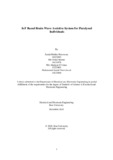IoT based brain-wave assistive system for paralyzed individuals
Abstract
Individuals suffering from severe paralysis encounter a multitude of issues that influence their
quality of life. Paralysis can occur due to impairments of the central nervous system (CNS)
causes by brain-stroke, accidents, neurodegenerative dysfunctions or other factors. A
significant portion of our society endures the consequences that limit their physical
functionalities such as movement, communication, task performances and so on. In recent
decades, technology has made substantial assistive devices that can communicate the
brainwave signals and interpret these into commands. The development of the brain-computer
interface (BCI) depends on the electric impulses generated in the brain. Hence, this can
consequently be implemented for improvement purposes, that can eventually help to overcome
the aspects of functional disabilities. To resolve the obstacles associated with paralysis, this
project of the brainwave-assistive system is based on the internet-of-things (IoT). The system
will be further comprised of multiple sensors that continuously acquire the brainwave
frequencies for implementation through the connected microcontroller.
For this project, the Cyton biosensing boards along with the WiFi shield have been utilised to
read the generated electric signals from the brain which have been differentiated as per the
functionality requirements. The WiFi shield enables the accumulated data to be saved in the
database henceforth can be accessed at any instance (in real-time basis) through the software
application. We have observed feedback generation through a microcontroller, we have further
transmitted the data utilizing LSL to Python for the control of computer application.
Furthermore, we intend to develop a mobile application that will frequently update the data
that would enable the user to visualize the brainwave signals on a dashboard. Further research
is required for a better understanding of the system to implement for extensive purposes such
as home enhanced mobility, appliance control, emergency alarm-system and so forth.

